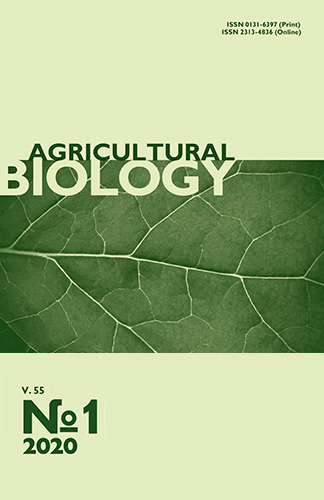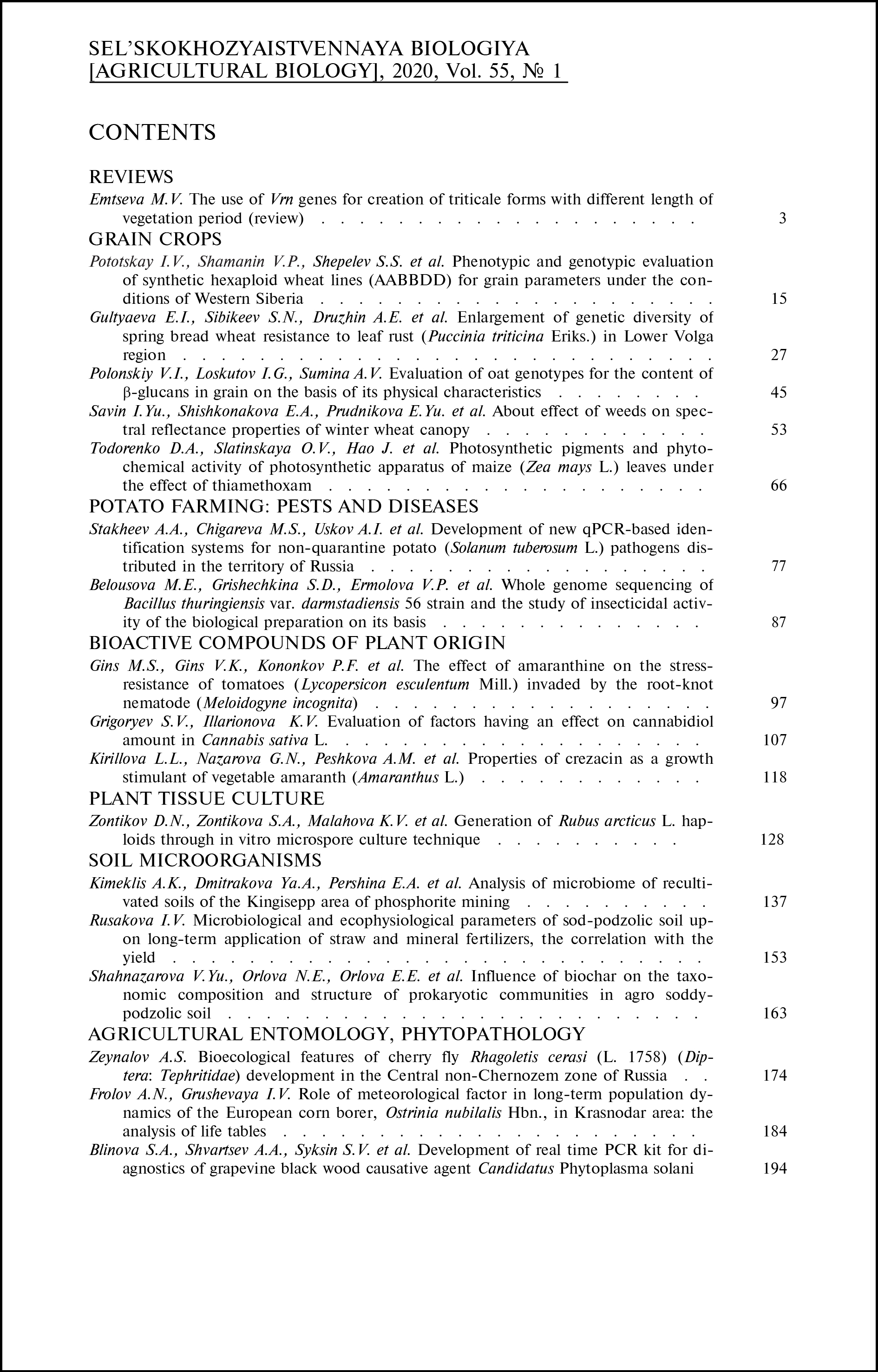doi: 10.15389/agrobiology.2020.1.128eng
UDC: 634.71:57.085.23
Acknowledgements:
Supported financially by the Russian Foundation for Basic Research, project No. 18-416-440002 р_а
GENERATION OF Rubus arcticus L. HAPLOIDS
THROUGH in vitro MICROSPORE CULTURE TECHNIQUE
D.N. Zontikov1, S.A. Zontikova1, K.V. Malahova1, E.V. Maramohin1, A.V. Poliykov2, R.V. Sergeev3
1Kostroma State University, 17, ul. Dzerzhinskogo, Kostroma, 156005 Russia, e-mail info@kstu.edu.ru, zontikovdn@mail.ru (corresponding author ✉), antennaria@mail.ru, maramokhin91@mail.ru, malakhova.kv1@gmail.com;
2All-Russian Research Institute of Vegetable Growing — Branch of the Federal Scientific Vegetable Center, str. 500, Vereya, Ramenskii District, Moscow Province, 140153 Russia, e-mail vita100plus@yandex.ru;
3Volga State University of Technology, 3, pl. Lenina, Yoshkar-Ola, Republic of Mari El, 424000 Russia, e-mail info@volgatech.net, rsergeyev@yahoo.com
ORCID:
Zontikov D.N. orcid.org/0000-0002-6668-4877
Maramohin E.V. orcid.org/0000-0002-1963-5845
Zontikova S.A. orcid.org/0000-0001-6566-4498
Poliykov A.V. orcid.org/0000-0002-0931-2751
Malahova K.V. orcid.org/0000-0002-7762-8811
Sergeev R.V. orcid.org/0000-0002-5070-9021
Received March 25, 2019
Arctic raspberry (Rubus arcticus L.) is a valuable small-fruit crop used as a plantation crop for a relatively short time. R. arcticus is a remontant donor in interspecific hybridization with Rubus idaeus L., though conditioning low yields to hybrids. So R. arcticus is primarily bred for yield enhancement; therefor, the acceleration of the breeding process is of great importance. This can be achieved using plants with a doubled haploid set of chromosomes. This paper is the first to describe the technique of production haploid plants of R. arcticus via in vitro microspore culture. In the experiments we used Finnish cultivars Pima and Mespi and Swedish cultivar Astra. To obtain donor explants, the method of forcing generative shoots was used throughout the year. Microspores were isolated from anthers with the use of manual homogenizer into a 1.5 ml micro test Eppendorf tube. The homogenate was added with 0.5 ml sterile water containing 30 g/l glucose, centrifuged at 4500 rpm, and the microspores were transferred with a microdoser to nutrient medium for morphogenesis initiation. To obtain microspores, the anthers were isolated from buds of 90 to 120 mm long 4-5 days before the flower bloomed. The concentration of the microspores in the suspension was about 40,000 per 0.5 ml sterile aqueous solution with glucose; for this, 60 anthers were crushed. To induce embryoidogenesis, we used the Murashige and Skoog (MS) plant growth medium supplemented with 0.50 to 2.00 mg/l growth regulator 6-benzylaminopurine (6-BAP). After the appearance of embryoids, we used MS, 75 % MS, or 50 % MS growth media, and also the effect of carbohydrate sources, i.e. glucose, sucrose and maltose at a 20, 30 and 40 g/l dosage, was investigated. We have identified the following microspore development stages: tetrads, non-vacuolated microspore, strongly vacuolated microspore, three-cell pollen. It was found that MS nutrient media containing 1.5 mg/l 6-BAP provides for 23±3 embryoids on day 51±2 of culture. We have also found the effect of MS concentration and the source of carbohydrate nutrition on the growth of embryoids. The combination of 0.75 MS and 30 g/l glucose was the most effective leading to embryoid growth on day 12±2 and the appearance of leaflets on day 44±1. On day 40 of culture the embryoids reached 5±0.2 mm in length. The ploidy control of regenerant plants, by counting chromosomes and chloroplasts in the stomata guard cells, confirmed the haploid set of chromosomes (n = 7). These findings allow the use of the proposed technique to generate R. arcticus haploids which, after doubling the chromosome set, may be involved in breeding.
Keywords: Rubus arcticus, haploid, diploid, microspore culture, embryoid, morphogenesis, regenerant plant.
REFERENCES
- Tyak G.V. Primenenie mineral'nykh udobrenii v posadkakh knyazheniki na vyrabotannom torfyanike. Materialy Mezhdunarodnoi nauchno-prakticheskoi konferentsii «Teoreticheskie i prikladnye aspekty ratsional'nogo ispol'zovaniya i vosproizvodstva nedrevesnoi produktsii lesa» [Proc. Int. Conf. «Theoretical and applied aspects of rational use and reproduction of non-timber forest products»]. Gomel', 2008: 305-308 (in Russ.).
- Karp K., Starast M. The Artic bramble (Rubus arcticus L.) cultivated in Estonia. Proc. Int. Conf. «Problems of rational utilization and reproduction of berry plants in boreal forests on the eve of the XXI century». Belarus, Gomel, 1997: 158-160.
- Vool E., Noormets M., Karp K., Mand R., Starast M. Pollinators and their foraging behavior in arctic bramble (Rubus arcticus L.) plantations in Estonia. Proc. International Conference «Integrative approaches towards sustainability in the Baltic Sea Region». Latvia, 2003: 481-489.
- Dvoryadkina A.G. Gaploidiya u kleshcheviny kak metod sozdaniya gomozigotnykh form v tselyakh selektsii. Avtoreferat kandidatskoi dissertatsii [Castor bean haploidy as a method for creating homozygous forms for breeding purposes. PhD Thesis]. Krasnodar, 1972 (in Russ.).
- Kruglova N.N. Embriologicheskie osnovy androklinii pshenitsy [Embryological basis of androkline wheat]. Moscow, 2005 (in Russ.).
- Kim K.-M., Baenziger P. A simple wheat haploid and doubled haploid production system using anther culture. In Vitro Cellular & Developmental Biology — Plant, 2005, 41(1): 22-27 CrossRef
- Duijs J.G., Voorrips R.E. Highly regenerative cultivars in microspore culture in Brassica oleraseae L. var. Capitata. Euphytica, 1992, 60: 45-55.
- Domblides E.A., Shmykova N.A. Sbornik nauchnykh trudov Vserossiiskogo NII selektsii i semenovodstva ovoshchnykh kul'tur. Moscow, 2002, vyp. 37: 82-92 (in Russ.).
- Gu H., Zhao Z., Sheng X., Yu H., Wang J. Efficient doubled haploid production in microspore culture of loose-curd cauliflower (Brassica oleracea var. botrytis). Euphytica, 2014, 195(3): 467-475 CrossRef
- Mandal A. Induction of androgenetic haploids in the breeding materials of winter rape (Brassica napus). Hereditas, 2008, 106(2): 189-193.
- Ilyushko M.V., Skaptsov M.V., Romashova M.V. Nuclear DNA content in rice (Oryza sativa L.), regenerants derived from anther culture in vitro. Sel'skokhozyaistvennaya biologiya [Agricultural Biology], 2018, 53(3): 531-538 CrossRef
- Kiszczak W., Kowalska U., Kapuścińska A., Burian M., Górecka K. Comparison of methods for obtaining doubled haploids of carrot. Acta Societatis Botanicorum Poloniae, 2017, 86(2): 3547 CrossRef
- Shmykova N.A. Sel'skokhozyaistvennaya biologiya [Agricultural Biology], 2001, 5: 53-60 (in Russ.).
- Tyukavin G.B., Shmykova N.A., Monakhova M.A. Fiziologiya rastenii, 1999, 46(6): 876-883 (in Russ.).
- Takahashi Y., Yokoi S., Takahata Y. Improvement of microspore culture method for multiple samples in Brassica. Breeding Science, 2012, 61: 96-98 CrossRef
- Na H., Kwak J.H., Chun C. The effect of plant growth regulators, activated charcoal, and AgNO3 on microspore derived embryo formation in broccoli (Brassica oleracea L. var. italica). Hortic. Environ. Biotechnol., 2011, 52(5): 524-529 CrossRef
- Sato S., Katoh N., Iwai S., Hagimori M. Effect of low temperature pretreatment of buds or inflorescence on isolated microspore culture in Brassica rapa (syn. B. campestris). Breeding Science, 2002, 52(1): 23-26 CrossRef
- Don Palmer C., Keller W.A. Overview of haploidy. In: Haploids in crop improvement II. Biotechnology in agriculture and forestry, vol. 56. C. Don Palmer, W.A. Keller, K.J. Kasha (eds.). Springer, Berlin, Heidelberg, 2005: 3-9 CrossRef
- Olmedilla A. Microspore embryogenesis. In: Plant developmental biology — biotechnological perspectives /E. Pua, M. Davey (eds.). Springer, Berlin, Heidelberg, 2010: 27-44 CrossRef
- Peixe A., Barroso J., Potes A., Pais M.S. Induction of haploid morphogenic calluses from in vitro cultured anthers of Prunus armeniaca cv. ‘Harcot’. Plant Cell, Tissue and Organ Culture (PCTOC), 2004, 77: 35-41 CrossRef
- Zontikov D., Zontikova S., Sergeev R., Sirotina M. Micropropagation of highly productive forms of diploid and triploid aspen. Advanced Materials Research, 2014, 962-965: 681-690 CrossRef
- Zontikov D., Zontikova S., Sergeev R., Shurgin A. In vitro propagation of Rubus chamaemorus L. and Rubus arcticus. Proc. Int. Conf. «14th International multidisciplinary scientific geoconference and EXPO». Albena, 2014: 397-403.
- Murashige T.A., Skoog F. A revised medium for rapid growth and bio assays with tobacco tissue cultures. Physiologia Plantarum, 1962, 15: 473-497.
- Pukhal'skii V.A. Tsitologiya i tsitogenetika rastenii [Plant cytology and cytogenetics]. Moscow, 2004 (in Russ.).
- Shumilina D.V., Shmykova N.A., Bondareva L.L., Suprunova T.P. Effect of genotype and medium culture content on microspore-derived embryo formation in Chinese cabbage (Brassica rapa ssp. chinensis) cv. Lastochka. Biology Bulletin, 2015, 42(4): 302-309 CrossRef
- Shmykova N.A., Shumilina D.V., Suprunova T.P. Vavilovskii zhurnal genetiki i selektsii, 2015, 1: 111-120 CrossRef (in Russ.).
- Lionneton E., Beuret W., Delaitre C., Ochatt S., Rancillac M. Improved microspore culture and doubled haploid plant regeneration in the brown condiment mustard (Brassica juncea). Plant Cell Reports, 2001, 20: 126-130 CrossRef
- Pivovarov V.F., Bondareva N.A., Shmykova N.A., Shumilina D.V., Mineikina A.I. New generation hybrids of white cabbage (Brassica oleracea L. convar. capitate var. alba DC) based on doubled haploids. Sel'skokhozyaistvennaya biologiya [Agricultural Biology], 2017, 52(1): 143-151 CrossRef
- Monakhos S.G., Nguen M.L., Bezbozhnaya A.V., Monakhos G.F. A relationship between ploidy level and the number of chloroplasts in stomatal guard cells in diploid and amphidiploid Brassica species. Sel'skokhozyaistvennaya biologiya [Agricultural Biology], 2014, 5: 44-54 CrossRef
- Yuan S., Liu Y., Fang Z., Yang L., Zhuang M., Zhang Y., Sun P. Study on the relationship between the ploidy level of microspore-derived plants and the number of chloroplast in stomatal guard cells in Brassica oleracea. Agricultural Sciences in China, 2009, 8(8): 939-946 CrossRef
- Soroka A.I. Differentiation of haploid and dihaploid rape plants at the cytological and morphological levels. Cytol. Genet., 2013, 47(2): 88-92 CrossRef
- Xynias I., Koufalis A., Gouli-Vavdinoudi E., Roupakias D. Factors affecting doubled haploid plant production via maize technique in bread wheat. Acta Biologica Cracoviensia s. Botanica, 2015, 56(2): 67-73 CrossRef
- Khokhar M.I., Razaq A., Iqbal J., Anwar M.J., Iqbal M.Z., ur Rehman S. Choice of maize genotype affects wheat haploid seed and success of embryo rescue. RADS Journal of Biological Research and Applied Science, 2019, 10(1): 1-5.












